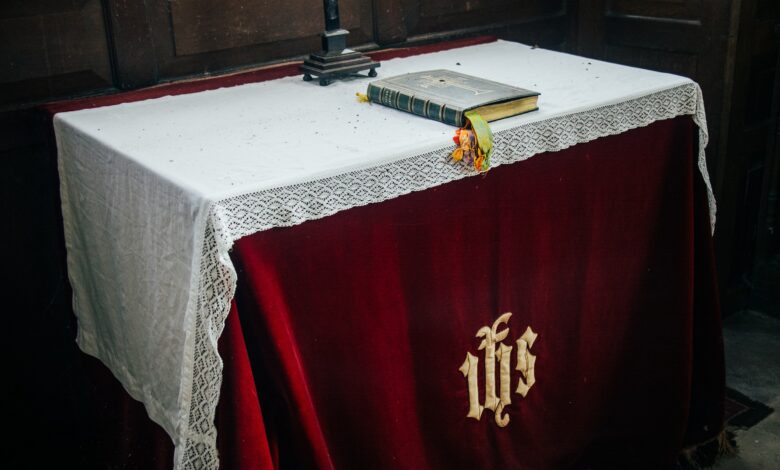How to Choose the Perfect Altar Clothing for Your Practice

As a spiritual practitioner, having the right altar clothing can be an important part of your practice. Not only can it create a sacred space for your practice, but it can also help you to connect with your spiritual traditions and beliefs. However, choosing the perfect Altar Clothing can be a daunting task, especially if you are new to the practice. In this blog post, we will provide you with a guide on how to choose the perfect altar clothing for your practice.
What is Altar Clothing?
Altar clothing is clothing that is used to cover the altar or sacred space during spiritual practices. This clothing can be made from various materials such as silk, cotton, or linen, and can be embroidered, painted, or embellished with symbols and patterns that are significant to your spiritual practice. Altar clothing can also be used to dress statues or other objects that are present on the altar.
Why is Altar Clothing Important?
Altar clothing is important because it helps to create a sacred space for your spiritual practice. By covering the altar or sacred space, you are creating a physical boundary between the mundane world and the spiritual world. Altar clothing can also help you to connect with your spiritual traditions and beliefs. By choosing clothing that is meaningful to you, you are reminding yourself of the spiritual values that are important to you.
Choosing the Perfect Altar Clothing for Your Practice
When choosing the perfect altar clothing for your practice, there are several factors to consider. Here are some tips to help you choose the right altar clothing for your practice:
1. Consider the Material
The first thing to consider when choosing Pentacle Altar Cloth is the material. The material you choose should be durable and easy to clean. Some common materials for altar clothing include silk, cotton, and linen. Each material has its own benefits and drawbacks, so it is important to choose a material that is suitable for your practice.
Silk is a luxurious material that is often used for altar clothing. It is smooth, soft, and lightweight, making it easy to handle. However, silk can be difficult to clean, and it is prone to wrinkles.
Cotton is a durable and easy-to-clean material that is often used for altar clothing. It is soft and breathable, making it a good choice for hot and humid climates. However, cotton can be heavy and may not drape as well as other materials.
Linen is a lightweight and breathable material that is often used for altar clothing. It is durable and easy to clean, making it a good choice for frequent use. However, linen can be stiff and may require ironing.
2. Consider the Color
The color of your altar clothing is also important. The color you choose should be significant to your spiritual practice. For example, in Hinduism, the color red is associated with prosperity and fertility, while the color yellow is associated with knowledge and learning. In Buddhism, the color orange is associated with enlightenment and wisdom, while the color blue is associated with calm and serenity.
When choosing the color of your altar clothing, it is important to consider the symbolism and meaning behind each color. You may also want to consider the colors of other items on your altar, such as candles or statues, to ensure that your altar clothing complements the overall aesthetic of your sacred space.
3. Consider the Design
The design of your altar clothing should also be significant to your spiritual practice. You may want to choose a design that features symbols or patterns that are important to your beliefs. For example, in Hinduism, the Om symbol is often used in altar clothing, while in Buddhism, the lotus flower is a common design element.
4. Consider the Size and Shape
The size and shape of your altar cloth should also be considered. The size should be appropriate for the size of your altar or sacred space. It should be big enough to cover the entire area but not too large that it overwhelms the space.
The shape of your altar clothing can also vary. Some people prefer rectangular shapes that drape over the altar, while others prefer more fitted designs that cover the altar like a tablecloth. The shape you choose should be based on personal preference and what works best for your altar.
5. Consider the Occasion
Finally, consider the occasion for which you will be using the altar cloth. Different occasions may call for different types of altar clothing. For example, if you are performing a ritual for a special occasion, you may want to choose a more elaborate design with intricate embroidery or embellishments.
On the other hand, if you are using the altar cloth for everyday practice, you may want to choose a simpler design that is easy to clean and maintain. It is important to choose altar clothing that is appropriate for the occasion and the level of formality of the practice.
Altar cloth is an important part of spiritual practice. It helps to create a sacred space for your practice and can help you to connect with your spiritual traditions and beliefs. When choosing the perfect altar clothing for your practice, consider the material, color, design, size and shape, and occasion. By taking these factors into consideration, you can choose altar cloth that is not only functional but also meaningful and significant to your spiritual practice.
Remember, there is no one “perfect” altar cloth for everyone. What is perfect for one person may not be perfect for another. The most important thing is to choose altar cloth that resonates with you and supports your spiritual practice.
So take the time to find the perfect altar clothing for your practice, and enjoy the benefits of creating a sacred space that reflects your spiritual values and beliefs.




